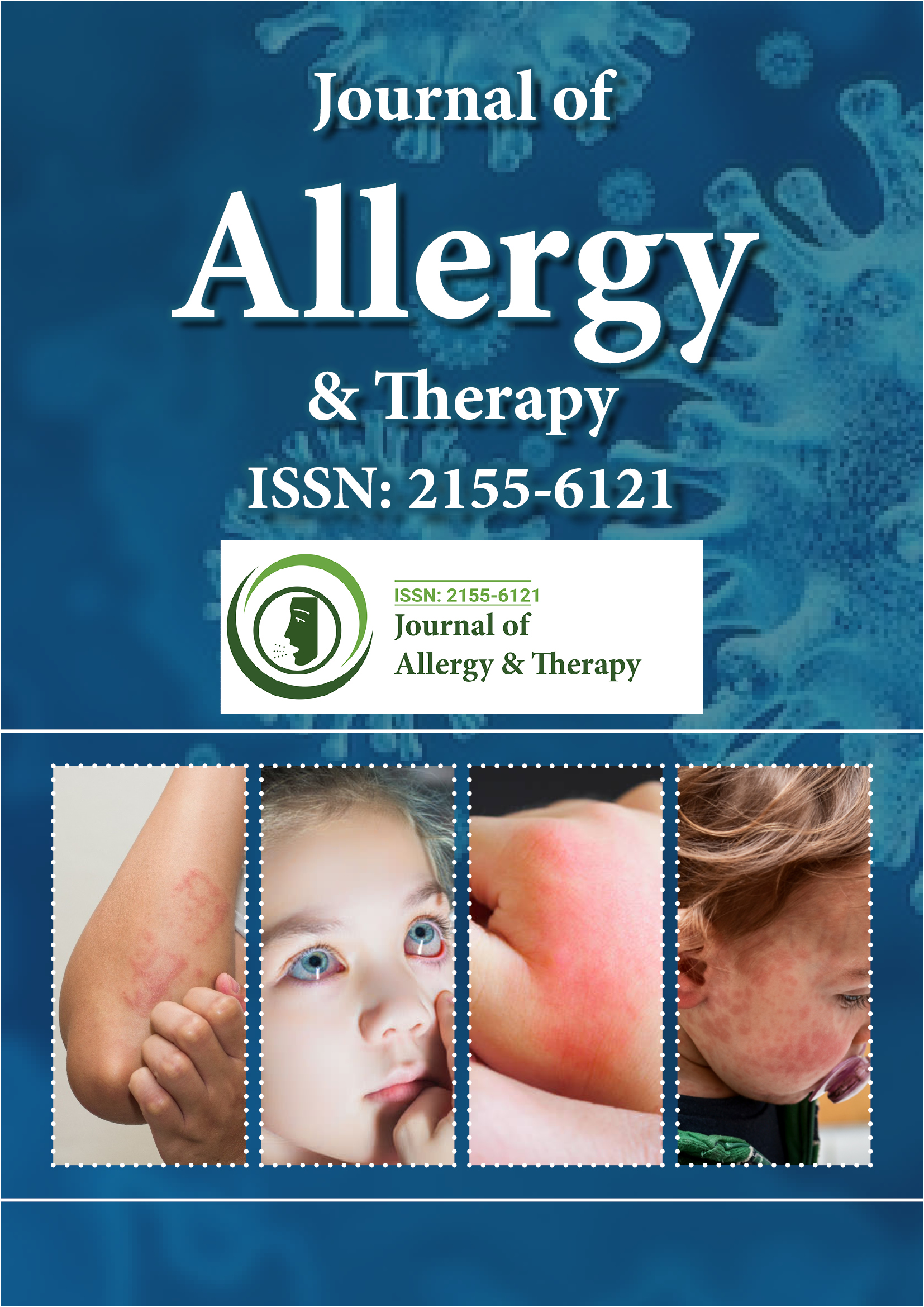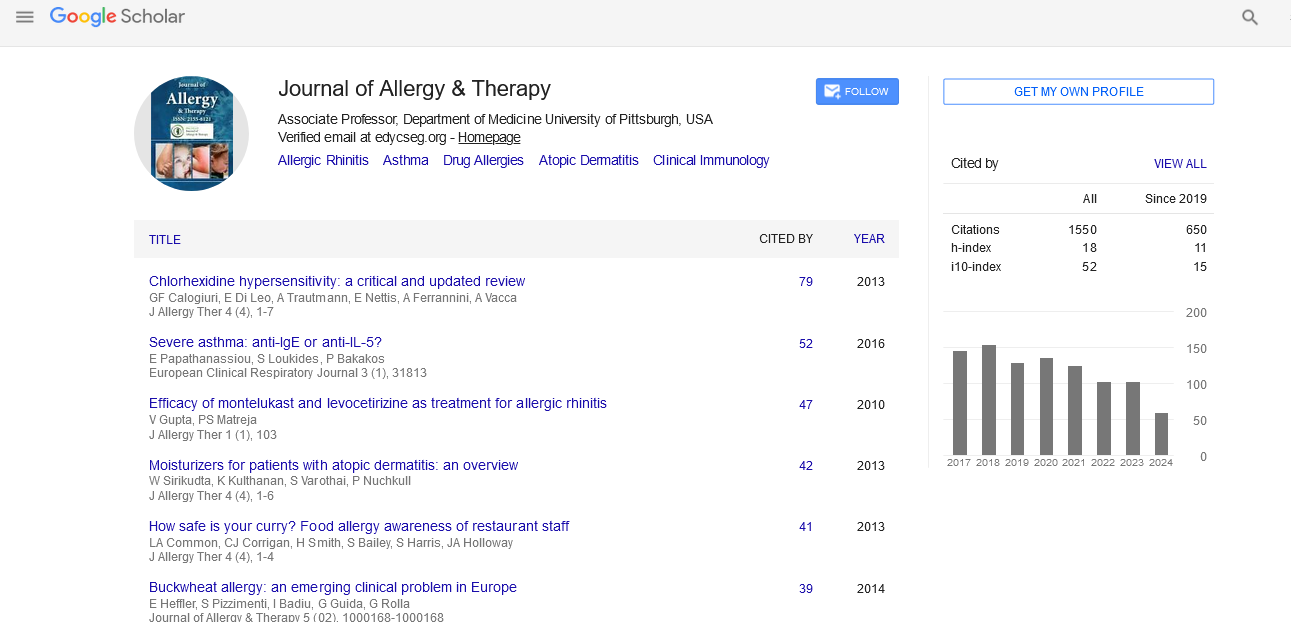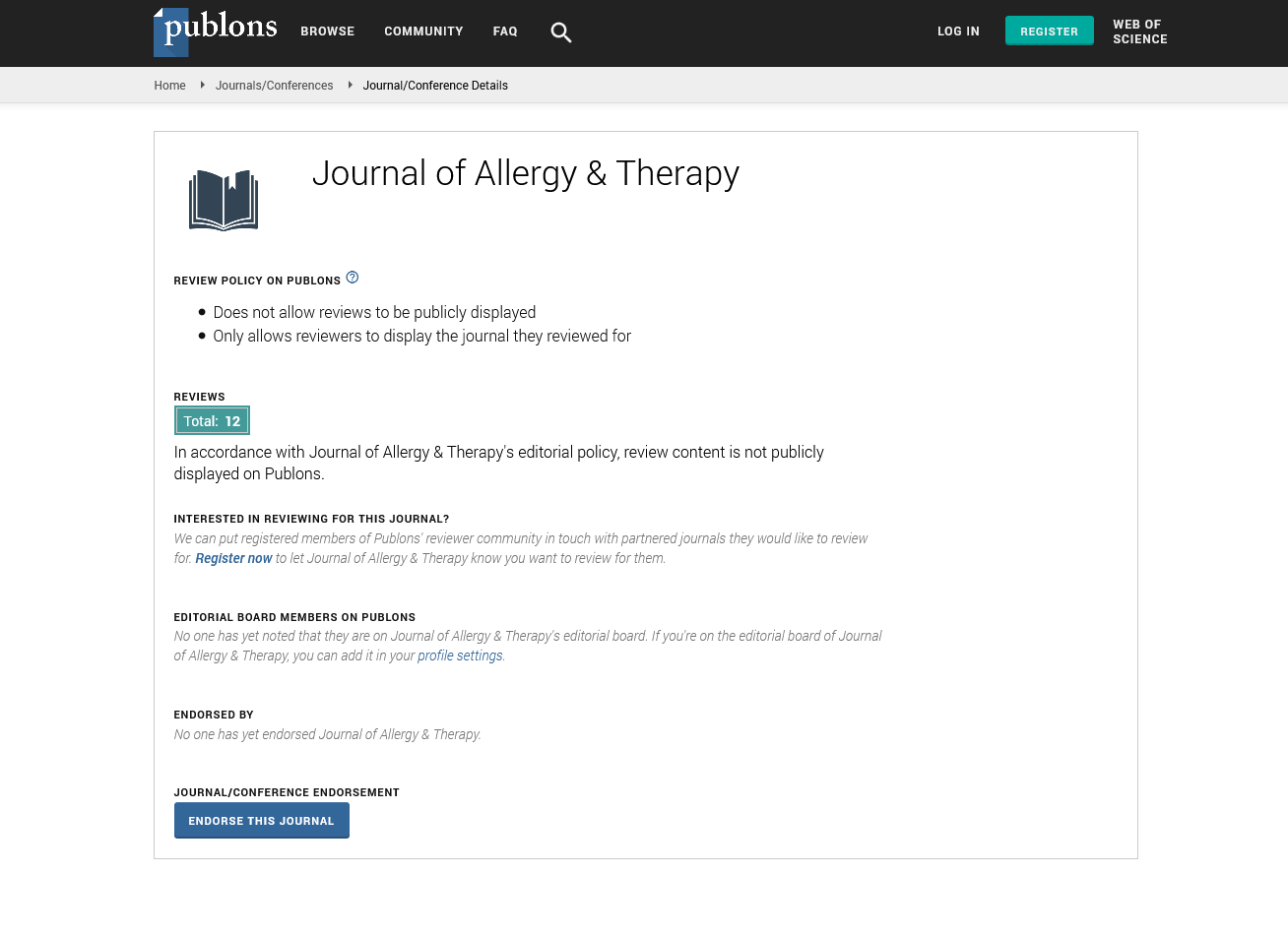Indexed In
- Academic Journals Database
- Open J Gate
- Genamics JournalSeek
- Academic Keys
- JournalTOCs
- China National Knowledge Infrastructure (CNKI)
- Ulrich's Periodicals Directory
- Electronic Journals Library
- RefSeek
- Hamdard University
- EBSCO A-Z
- OCLC- WorldCat
- SWB online catalog
- Virtual Library of Biology (vifabio)
- Publons
- Geneva Foundation for Medical Education and Research
- Euro Pub
- Google Scholar
Useful Links
Share This Page
Journal Flyer

Open Access Journals
- Agri and Aquaculture
- Biochemistry
- Bioinformatics & Systems Biology
- Business & Management
- Chemistry
- Clinical Sciences
- Engineering
- Food & Nutrition
- General Science
- Genetics & Molecular Biology
- Immunology & Microbiology
- Medical Sciences
- Neuroscience & Psychology
- Nursing & Health Care
- Pharmaceutical Sciences
Research Article - (2025) Volume 16, Issue 1
Study on the Food Behaviors of Patients with Food Allergy in Southern France
Marie Lagreula1*, Pascal Demoly1,2 and Anca-Mirela Chiriac1,22Department of Pulmonology, Sorbonne University, Paris, France
Received: 28-Jan-2020, Manuscript No. JAT-24-3243;; Editor assigned: 31-Jan-2020, Pre QC No. JAT-24-3243 (PQ); Reviewed: 14-Feb-2020, QC No. JAT-24-3243;; Revised: 01-Aug-2024, Manuscript No. JAT-24-3243 (R); Published: 29-Aug-2024
Abstract
Food Allergy (FA) is associated with an important physical and psychological burden. Accurate and comprehensible information about the presence of allergens in food and drink products is essential to successfully avoid trigger food. According to the previous European Union (EU) legislation, presence of any of the fourteen priority allergen sources as ingredients in pre-packed food must be declared.
Keywords
Food allergy; Allergens; European union; Food
Introduction
The EU food information for consumers required this mandatory disclosure to be extended to non-prepacked foods in December 2014. As a protection from lawsuits, most food producers use Precautionary Allergen Labeling (PAL) to alert consumers about the possible unintended presence of allergens. The use of PAL is voluntary and not covered specifically by existing legislation although it has been argued that general food safety law applies.
Studies have shown that Quality of Life (QoL) of FA patients is reduced. PAL, by generating confusion among consumers, can lead to loss of trust in this precautionary statement [1].
The aim of our study was to evaluate the consumers’ behavior among patients with FA and to search for risk factors for consuming trigger allergens (e.g; use of PAL) we also studied the QoL of these patients.
This observational study was conducted within the allergy unit of the university hospital of Montpellier, France, between December 2014 and June 2017. All consecutive patients entering the inclusion criteria (without limitation of age) consulting in our unit and having a FA for any food answered the consumption questionnaire, after signing an informed consent. Inclusion criteria were patients with allergist-confirmed FA, diagnosed by clinical history, positive skin prick-test (with native food) and specific IgE (Immuno CAP Phadia, Thermo Fisher Scientific®, Uppsala Sweden) for the culprit food or positive OFC. All patients had to be in avoidance of the target/culprit food. The questionnaire was completed by the patients or their parents (for patients under 12 years of age) and was divided in 6 parts: Personal information, behavior in supermarkets, behavior in food markets and with artisanal food, behavior at restaurants, behavior during holidays and QoL [2]. This questionnaire was designed based on: (i) literature data (review of PubMed articles using the MeSH terms «quality of life», «food allergy», «precautionary labeling», «voluntary incidental trace allergen labeling», «health-related quality of life»); (ii) discussions with the French Association of Food Allergic Patients (AFPRAL); (iii) discussions with numerous individual patients and/or their parents. The QoL part contained 11 questions about anxiety adapted from the Food Allergy Quality of Life Questionnaire (FAQLQ). Our questionnaire is shown in the online repository.
Materials and Methods
The primary assessment criterion was the frequency of labels ‘reading by the patients or their parents. Patients answered the question “Do you read the labels of the products you eat?” using a numeric scale from 0 to 10, where 10 stands for 100% of the time (i.e., always). To allow statistical analysis, continuous data of the results were transformed into a dichotomous variable (i.e., reading the labels “at least 80% of the time” and “less than 80% of the time”). “Almost always” in the text referred to patients reading the labels at least 80% of the time [3]. The cut-off of 80% was chosen because of clinical significance. Secondary assessment criteria were the score of QoL of these patients and risk factors for almost always reading of the labels. The qualitative variables were reported in frequency and percentages, an a chi-square test was used to compare results between subgroups. The mean of quantitative variables was calculated. For the risk factor analysis, we carried out a logistic regression modeling (univariate and multivariate analysis, independent variables with p ≤ 0.25 were kept for multivariate modeling). A p-value<0.05 was considered as significant. Statistical analysis was conducted using SAS Studio 3.71. The local ethics committee approved the study [4].
Results
A hundred and two patients were included, 54% were females, 66% were children and mean age was 18 years (± 14), 62% with multiple food allergy. The most frequent FA (including multiple food allergies) were to: Nuts (53%), peanut (51%), fruits (25%) and egg (16%). In our study, 75% of patients had already experienced an anaphylactic reaction (grade 2 or 3). The same proportion of patients carried an epinephrine auto-injector on an everyday basis. The initial diagnosis of FA was established by allergists in 49% of cases, followed by pediatricians (11%), family members (9%), general practitioners (5%) and others (6%). In 20% of cases, participants mentioned first suspicion of diagnosis as a self-diagnosis (Table 1) [5].
| Clinical characteristics of the studied population | Total of included patients N=102 | “Almost always” label readers N (%) | P |
|---|---|---|---|
| Allergen | |||
| Peanut | 33 | 17 (51.5) | 0.04 |
| Nuts | 54 | 18 (81.8) | |
| Fruits | 25 | 5 (62.5) | |
| Other | 84 | 63 (75) | |
| Severity of initial reaction* | |||
| Grade 0 | 25 | 13 (12.7) | 0.002 |
| Grade 1 | 70 | 45 (44.1) | |
| Grade 2 | 7 | 1 (58.7) | |
| Bronchospasm during initial reaction | |||
| No | 103 | 86 (83.5) | 0.13 |
| Yes | 44 | 32 (72.5) | |
| Other atopic disease** | |||
| No | 5 | 4 (80) | 0.60 |
| Yes | 141 | 98 (69.5) | |
Note: *Grade 0: Eviction on skin test; grade 1: Anaphylaxis; grade 2: Anaphylactic shock **atopic rhinitis, atopic dermatitis, atopic asthma, other food allergy
Table 1: Descriptive analysis of the studied population and the “almost always” (>80% of the time) label readers.
Sixty percent of patients read “almost always” the labels and among them, 40% read them always. The answers related to the “food behaviour” part of the questionnaire revealed that 75.5% did shopping in supermarkets and 58% in artisanal markets; 62% changed producers for the same product and 61% changed their artisanal sellers. Most patients (72%) ate food mentioning PAL with their culprit allergen, 48% asked the composition of everything they ate, 70% trusted sellers and 2% never ate products that had not been cooked by themselves/their parents. When asked “Why don’t you trust sellers?” (i) 64% answered because sellers lacked knowledges, (ii) 15% thought sellers minimise allergic risk, (iii) 13% were afraid of an allergic reaction and (iv) 8% because they had already had an accidental reaction with a food containing their allergen.
Concerning the QoL, the PAL annoyed 70% of the allergic patients in our study. The mean score of QoL was 36 (SD=17) for a maximum score of 66. The univariate analysis for risk factors of frequency of label reading is presented in Table 2. We only found 2 independent risk factors for “almost always” reading the labels: Asking the composition of nonpackaged product (OR=0.0015 ((0.002-0.111), p<0.001) and finding it troublesome to explain their allergy to others (OR=0.5 ((0.28-0.9), p=0.04)) [6].
| Risk factor | Univariate analysis | ||
|---|---|---|---|
| Unadjusted OR | CI 95% | p | |
| Change of label | |||
| Yes | 1 | ||
| No | 3.19 | (1.33-7.63) | <0.01 |
| Change of artisanal seller | |||
| Yes | 1 | ||
| No | 1.95 | (0.85-4.46) | 0.11 |
| Vigilance of labels during holidays | |||
| Yes | 1 | ||
| No | 0.4 | (0.18-0.89) | 0.02 |
| Asking composition of non-prepared food | |||
| Yes | 1 | ||
| No | 0.03 | (0.01-0.10) | <0.0001 |
| Having an epinephrine autoinjector pen | |||
| Yes | 1 | ||
| No | 0.3 | (0.12-0.78) | 0.01 |
| Be troublesome/annoyed | |||
| To always be alert to watch what I eat | 1.44 | (0.95-2.20) | 0.08 |
| To eat fewer products | 1.4 | (1.14-1.73) | 0.002 |
| To be limited to the product I can buy | 1.49 | (1.19-1.86) | 0.0005 |
| To eat out less | 1.27 | (1.05-1.55) | 0.01 |
| To explain to others about FA | 1.26 | (1.01-1.48) | 0.04 |
| When ingredients change in the product | 1.53 | (1.22-1.90) | <0.01 |
| By the label stating PAL | 1.31 | (1.08-1.58) | <0.01 |
| Be worried about an allergic reaction | 1.2 | (0.96-1.50) | 0.1 |
| Be worried about eating the wrong food | 1.18 | (0.96-1.45) | 0.12 |
| Impact on activities with others | 1.5 | (1.16-1.96) | <0.01 |
| QoL | 1.03 | (0.99-1.07) | 0.05 |
Note: FA-Food Allergy; PAL-Precautionary Allergy Labeling; QoL-Quality of Life
Table 2: Risk factors of «almost always» reading the labels. Significant risk factors (p<0.05) in univariate are in italics/bold.
Our study is the first study in France that analyzed food behavior among food allergy patients without focusing on a specific allergen. A previous study (MIRABEL) has investigated food behavior among patients suffering from peanut allergy only [7].
In our study, 60% of patients with FA “almost always” read the labels of the packed products they bought, with 40% of them (namely 24% of all patients) always reading them. Twenty-eight percent did not consume products with the PAL, confirming findings of a previous study conducted in the UK in 2013, which found 34% of patients reading the labels systematically and never consuming products with PAL.
Seventy percent of the allergic patients discounted PAL in our study, suggesting that PAL does not help them in their food choices. Indeed, ¾ of the studied population mentioned consuming food containing PAL, which is coherent with the study of Cochrane, et al. We also showed that the more the patients are annoyed to explain their allergy, the more the frequency of reading the labels falls, potentially exposing these patients to an accidental intake of their allergen(s) [8].
Discussion
Finally, we detected that the severity of the initial allergic reaction had no influence on the behavior of the consumer. This finding is in correlation with others studies, except one that pointed out a significant association between the severity of FA and more cautious buying behaviors. Likewise, the prescription of an epinephrine auto-injector did not come out as a risk factor for “almost always” reading the labels. However, this prescription is generally not only related to the severity of the initial allergic reaction but more often to the potential severity of further relapses [9].
Our study has some limitations. The patients or their parents answered the questionnaire a posterior, during their visit in our allergy unit that might have induced a recall bias. Furthermore, patients were recruited within the allergy unit of a tertiary care hospital, possibly inducing a selection bias, by including patients with a potentially more severe FA. For QoL assessment, we used a questionnaire extracted from the French validated questionnaire adult form (FAQLQ-adult form), adapted for children when it was necessary (FAQLQ-children form). Since we did not use the complete versions of these questionnaires, we were not able to compare some variables, like the low mean QoL score in our study, to values obtained in other studies. Finally, we did not differentiate the fact of reading the PAL from reading the label that can explain discrepancies between our results and some of other studies [10].
Conclusion
In conclusion, 60% of the patients in our study read more than 80% of the time the labels of the products they eat and amongst them, 40% always read them. PAL was of limited effectiveness since ¾ of patients discard it. Patients who were annoyed at explaining their allergy to others could represent a subpopulation at risk of accidental exposure to allergens, due to rare reading of labels. This study suggests that QoL of this population is reduced.
Conflicts of Interest
The authors declare no conflicts of interest for this work.
References
- Turner PJ, Kemp AS, Campbell DE. Advisory food labels: Consumers with allergies need more than “traces” of information. BMJ. 2011;343.
[Crossref] [Google Scholar] [PubMed]
- Flokstra-de Blok BM, DunnGalvin A, Vlieg-Boerstra BJ, Elberink JN, Duiverman EJ, Hourihane JO, et al. Development and validation of the self-administered food allergy quality of life questionnaire for adolescents. J Allergy Clin Immunol. 2008;122(1):139-144.
[Crossref] [Google Scholar] [PubMed]
- Flokstra‐de Blok BM, DunnGalvin A, Vlieg‐Boerstra BJ, Oude Elberink JN, Duiverman EJ, Hourihane JO, et al. Development and validation of a self‐administered food allergy quality of life questionnaire for children. Clin Exp Allergy. 2009;39(1):127-137.
[Crossref] [Google Scholar] [PubMed]
- Flokstra‐de Blok BM, van Der Meulen GN, DunnGalvin A, Vlieg‐Boerstra BJ, Oude Elberink JN, Duiverman EJ, et al. Development and validation of the food allergy quality of life questionnaire-adult form. Allergy. 2009;64(8):1209-1217.
[Crossref] [Google Scholar] [PubMed]
- van Der Velde JL, Flokstra‐de Blok BM, Vlieg‐Boerstra BJ, Oude Elberink JN, DunnGalvin A, Hourihane JO, et al. Development, validity and reliability of the food allergy independent measure (FAIM). Allergy. 2010;65(5):630-635.
[Crossref] [Google Scholar] [PubMed]
- DunnGalvin A, Cullinane C, Daly DA, Flokstra‐de Blok BM, Dubois AE, Hourihane JO. Longitudinal validity and responsiveness of the food allergy quality of life questionnaire–parent form in children 0-12 years following positive and negative food challenges. Clin Exp Allergy. 2010;40(3):476-485.
[Crossref] [Google Scholar] [PubMed]
- Cochrane SA, Gowland MH, Sheffield D, Crevel RW. Characteristics and purchasing behaviours of food-allergic consumers and those who buy food for them in Great Britain. Clin Transl Allergy. 2013;3:1-8.
[Crossref] [Google Scholar] [PubMed]
- Wassenberg J, Cochard MM, DunnGalvin A, Ballabeni P, Flokstra‐de Blok BM, Newman CJ, et al. Parent perceived quality of life is age‐dependent in children with food allergy. Pediatr Allergy Immunol. 2012;23(5):412-419.
[Crossref] [Google Scholar] [PubMed]
- Nucci D, Santangelo OE, Provenzano S, Nardi M, Firenze A, Gianfredi V. Altered food behavior and cancer: A systematic review of the literature. Int J Environ Res Public Health. 2022;19(16):10299.
[Crossref] [Google Scholar] [PubMed]
- Nolden AA, Hwang LD, Boltong A, Reed DR. Chemosensory changes from cancer treatment and their effects on patients’ food behavior: A scoping review. Nutrients. 2019;11(10):2285.
[Crossref] [Google Scholar] [PubMed]
Citation: Lagreula M, Demoly P, Chiriac AM (2024) Study on the Food Behaviors of Patients with Food Allergy in Southern France. J Allergy Ther. 15:399.
Copyright: © 2024 Lagreula M, et al. This is an open-access article distributed under the terms of the Creative Commons Attribution License, which permits unrestricted use, distribution, and reproduction in any medium, provided the original author and source are credited.


